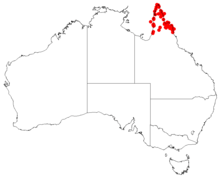Hakea pedunculata
Hakea pedunculata is a shrub or small tree of the genus Hakea comprising approximately 150 species restricted to Australia. This species is found in the Far North region of Queensland and adjacent islands. Most Hakea seed are usually dispersed by an environmental trigger rather than when seed matures, quite often by fire. Whilst other species may require sporadic flooding rains to establish.
| Hakea pedunculata | |
|---|---|
| Scientific classification | |
| Kingdom: | Plantae |
| Clade: | Tracheophytes |
| Clade: | Angiosperms |
| Clade: | Eudicots |
| Order: | Proteales |
| Family: | Proteaceae |
| Genus: | Hakea |
| Species: | H. pedunculata |
| Binomial name | |
| Hakea pedunculata | |
 | |
| Occurrence data from Australasian Virtual Herbarium | |
Description
The shrub or small tree is often gnarled and typically grows to a height of 1 to 5 metres (3 ft 3 in to 16 ft 5 in). It has finely fissured dark colored bark and flat leaves that are narrowly to broadly egg shaped and grow to a length of 5 to 10 centimetres (2 to 4 in) and a width of 8 to 20 millimetres (0.31 to 0.79 in). About forty cream-white flowers are arranged in a group on a stalk 6.5–25 mm (0.3–1 in) long, each flower on a slightly rough pedicel 2–10 mm (0.08–0.4 in) long that is covered with white soft hairs. Fruit are obliquely egg-shaped tapering at each end or three dimensional and 2 to 3 cm (0.79 to 1.18 in) long and 1 to 1.2 cm (0.39 to 0.47 in) wide, ending in a short backward curving beak about 2–3 mm (0.08–0.1 in) long. Hakea pedunculata flowers predominantly from April to August and occasionally in February.[1] The woodiness of Hakea is determined when the fruit ripens and the two valves open displaying a darker and lighter zone. Those species with a greater pale layer tend to retain their seed longer. Hakea pedunculata is unique in the Pedunculata group for its fruit woodiness and swampy habitat.
Taxonomy and naming
Hakea pedunculata was first formally described by Ferdinand von Mueller in 1883 from a specimen collected by a druggist, W. Anthony Persieh, from a specimen collected near Endeavour River.[2][3][4] Hakea persiehana was named in his honour by Mueller in 1886.[1] The specific epithet (pedunculata) is derived from the Latin word pedunculus meaning "a small, slender stalk",[5] referring to its peduncle- the stalk beneath the inflorescence, which is much longer than in other species of Hakea.[1]
Distribution and habitat
Hakea pedunculata grows north of Cooktown on Cape York Peninsula a large peninsula in far North Queensland and adjacent islands. Often found in landward edges of mangroves or semi-swamp areas in low shrubland where Melaleuca is dominant.[1]
Conservation status
Hakea pedunculata is considered "least concern" by the Department of Environment and Science, Queensland.[6]
References
- "Hakea pedunculata". Flora of South Australia. South Australian Government. Retrieved 10 December 2018.
- "Hakea pedunculata". APNI. Retrieved 9 December 2018.
- "Australian Plant Collectors and Illustrators (P–Q)". APNI. Retrieved 9 December 2018.
- Mueller, F.J.H. von (1883) Notes on new species of Hakea. Australasian Chemist and Druggist 6: 23
- Brown, Roland Wilbur (1956). The Composition of Scientific Words. Washington, D.C.: Smithsonian Institution Press. p. 751.
- "Hakea pedunculata". WetlandsInfo Department of Environment and Science, Queensland. Retrieved 9 December 2018.